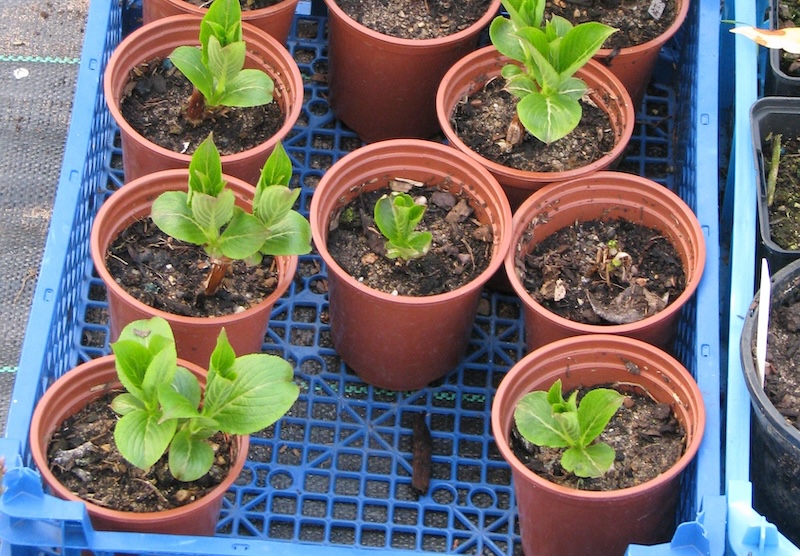The best way to propagate Weigela shrubs is by taking cuttings. You can take cuttings from soft new growth in the early summer or from the mature hardwood stems in the fall. Both types of cuttings will result in shrubs that are genetically identical to the mother plant. Mastering the art of softwood and hardwood cuttings will make it easier for you to grow more shrubs and perennials to plant or give away to friends and family.
The tools required for taking cuttings are all commonly found in your garden shed and there is no need to use fancy or expensive rooting compounds in most cases. Cuttings of shrubs are usually ready to be planted in a garden bed after one to two years of growth.

Photo by peganum, cropped, Flickr, Copyright CC BY-SA 2.0 DEED
Methods To Propagate Weigela
Softwood cuttings are the quickest to set roots and should be taken after the flowering cycle ends in early summer. Cut a 6-10 inch section of new growth without any flower buds just below a set of leaves. The nodes at each of the leaf joints are where new roots can form in propagation media.
Take semi-hardwood and hardwood cuttings in the same way as the softwood type, but wait until late summer or fall, when the new growth starts to turn woody. This type of cutting will take a bit longer to strike and grow new roots, but the plant should be ready to plant in the garden within a year.
What You Need To Propagate Weigela
Both softwood and hardwood cuttings use tools that most gardeners have readily on hand. You will need a pair of sharp and sterilized hand-held pruners, a sterilized pocket or utility knife, a small bottle of rubbing alcohol to quickly sterilize tools, small 4-6 inch pots with good drainage, potting mix with added perlite or straight perlite, and a watering can with a fine spray. Commercially available rooting hormone is often recommended for cuttings, but it is purely optional and some plants root better without it.
Best Time To Propagate Weigela
Softwood cuttings are best taken after flowering has finished in early summer. During a pruning session, take some of the new growth from the tip of the branches; avoid cutting stems with flower buds. Take hardwood cuttings after the first frost, as the plant goes dormant, or take semi-hardwood cuttings in late summer or early fall, as the new growth becomes woody. Select branch tips without flower buds forming for next year's display.
Steps To Propagate Weigela
Step 1 - Cut a length of stem that is 6-10 inches long. Cut just below a pair of leaves, making sure the stem has at least 3 sets of leaves. Take multiple cuttings to ensure that at least one plant strikes.
Step 2 - Remove the lower leaves carefully from the stem to avoid injuring any nodes. Use a sterilized knife to do this cleanly. Leave the top leaves on the stem to allow photosynthesis. If the leaves are very large, cut them in half.
Step 3 - Fill a 4-6 inch-diameter pot with all-purpose potting soil mixed with perlite, or use straight perlite. Each pot can hold up to five cuttings.
Step 4 - Water the potting medium well before planting the cuttings.
Step 5 - Place the cuttings around the edges of the pot for the best root growth. If using a square pot, place one cutting in each of the four corners and a fifth in the middle of the pot.
Step 6 - Place the potted cuttings in a semi-shaded location with shelter from direct sun and heavy rains or winds.

Photo by Kenneth Hong, unedited, Flickr, copyright CC BY-ND 2.0 DEED
Caring For Young Weigela
Cuttings will take a few weeks to strike roots and grow new foliage. Keep the pots well watered so that the tender new root hairs stay sufficiently hydrated. There is little danger of overwatering cuttings when they are planted in a pot with excellent drainage and a high amount of perlite. New foliage growing from the stem indicates a root system is forming.
Weigela cuttings can be left outside in a protected space, such as an unheated greenhouse or frost-free garage, to grow through the winter. In the spring, each new plant can be moved to its own pot for a growing season or more. Keep the pots well watered in the holding area and check regularly for slugs or snails that can do damage to tender, young growth.
Hardwood cuttings will be ready to plant in the garden after one year of growth. Softwood cuttings may take longer to reach a manageable size for planting in the ground.
 |
Author Robbin Small - Published 12-13-2023 |
